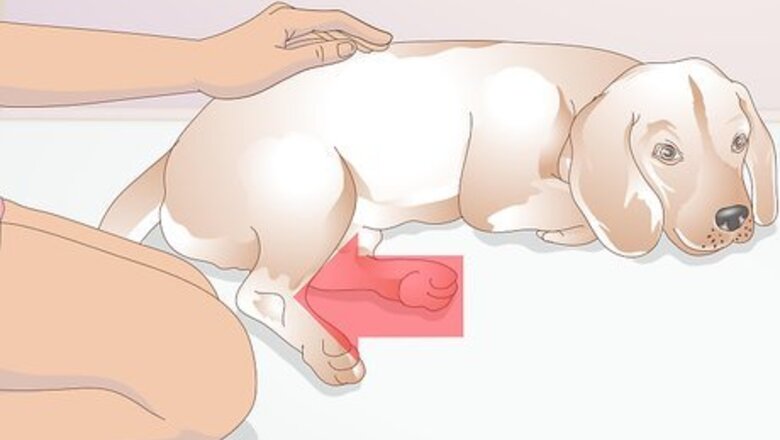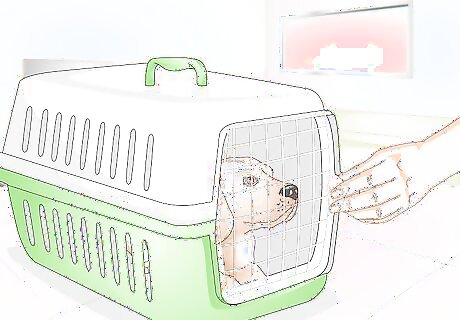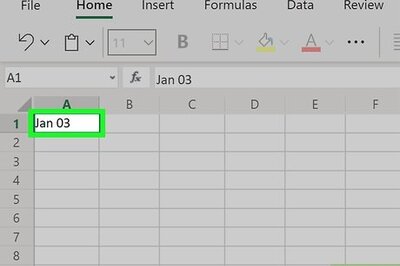
views
X
Research source
The method used to treat the broken bone depends on the type of fracture involved. Learn how to identify the type of fracture so you can treat your dog accordingly.
Disclaimer: Veterinary professionals advise against dog owners splinting their pet's broken bone at home due to improper application of the bandage (which can lead to a tourniquet effect of the bandage), skin infection, and improper positioning of the leg, as well as wounds from the bandage chafing or rubbing.
Splinting Your Dog’s Leg

Decide if you want to splint the leg. If the leg is obviously broken and no bones are sticking through the skin, you can splint the leg. You should only consider splinting the leg if you cannot get to the vet right away or it is a long journey to the vet. Splinting is a controversial practice because if done incorrectly, it applies pressure to the ends of the broken bone and can cause more pain for your dog. However, if done correctly, it stops the bones moving, gives them further support, and helps ease discomfort. Be aware that handling the broken leg will be painful, so you may need to muzzle the dog to stop him from biting in self defense. Splinting works best if the fracture is below the elbow or the knee. The big muscles groups of the shoulder and hip get in the way of bandages and cause them to slip down, which can cause a problem if the break is in the humerus (upper arm) or thigh (femur). Those fractures are best left unsupported and the dog kept caged until you can get help.

Gather materials. Make sure you have the proper materials to splint your dog's broken bone before starting. To splint limb, you need a firm straight object that is the same length as the broken bone. Household items such as a wooden spoon, wooden spatula, or ruler can be used, depending on the dog's size. You also need some gauze and self-adhesive tape.

Cover the area with gauze. Before you place a splint on the dog’s leg, cover the area with gauze. Wrap a layer of gauze bandage firmly around the limb from the paw, up over the fracture site, and up over the joint above the fracture. Wind the gauze in a spiral fashion with each loop overlapping the previous one. Covering the area in gauze helps prevent the splint rubbing the skin and causing sores.

Wrap the splint in place. Hold the splint over the fracture site. Wrap dressing tape around the splint and leg to tape the splint firmly in place. Now apply a spiral layer of bandage over the top of the splint, applied firmly but not tight. Finish with a layer of self-adhesive bandage. This all helps to immobilise the joints above and below the splint and hold the splint in place. Use enough pressure on the tape so that the fit is snug, but not tight.

Monitor for swelling. After splinting the leg, you should monitor the paw closely for any signs of swelling. Swelling can indicate the dressing is too tight. If the paw is swollen, you should release the dressing immediately. Lack of circulation to the limb can cause tissue death and gangrene. Keep the dressing dry. Never use a splint in place of professional vet treatment for broken bones. Take your dog to get professional veterinary help as soon as possible.
Treating Open Wound Breaks

Keep the wound clean. If bone is sticking out through the skin, do not attempt to splint the leg. Instead, keep the ends of the bone and the skin wound as clean as possible. Lay a sterile gauze bandage from a first aid kit over the open wound. If you don't have any gauze handy, place any clean cotton garment, such as a T-shirt or a handkerchief, over the area. The goal is to prevent bacteria from the atmosphere further contaminating the wound.

Make the dog lie down on the uninjured side. Encourage your dog to lie down on the uninjured side, with the leg with the open wound on top. Attempt to keep the leg straight from the hip instead of letting it flap down. To do this, roll up a towel or a piece of clothing and place it underneath the leg to provide something for it to rest on. Be very gentle when you place the towel beneath the dog’s leg. Moving the leg will cause pain, so take care to cause as little pain as possible.

Apply gentle pressure to bleeding. Open wounds may present the added problem of bleeding. If your dog’s open wound is bleeding, apply gentle, easy pressure to try to stop the bleeding. Hold a clean towel or gauze against the wound until it stops.

Take the dog to the vet as soon as possible. Take your dog to the vet as soon as you can. When you put him in your vehicle, make sure to prop the leg up straight using the towel. You can have someone sit in the back with him if you can to help. Make sure to drive carefully, avoiding unnecessary bumps. Open fractures are painful so don't be surprised if a normally placid or sweet dog attempts to snap at you. Stay calm, and if necessary, muzzle him or have another person hold his head.
Getting Medical Care for a Broken Bone

Get a cast. For some breaks, your vet may put a cast on your dog. The cast helps keep the dog’s leg at a certain angle and reduces movement. A cast can only be placed on certain locations on the body due to the way it fits on the dog. For a simple crack in the bone or a non-displaced fracture, then a cast may be sufficient. Puppies heal much more quickly than older dogs, so they may also get a cast.

Undergo surgery. For more complex fractures or breaks, your dog may require surgery. Breaks in adult or older dogs often are repaired through open surgery. During surgery, the dog is given an anesthetic. The surgeon opens the tissues overlying the bone to gain access to the fracture. One method used in surgery is to stabilize the bones using a metal pin which is passed up through core of the bone to realign the fractures. Alternatively, the vet may use special metal plates which are screwed either side of the fracture to hold everything in place. For exceptionally complex fractures where the bone is broken in several pieces, an internal-external fixator is used. This is where pins are placed at right angles to the bone and the pins supported on an external scaffolding system.

Monitor your dog carefully during recovery. Regardless of the treatment method, it is essential your dog is rested for the duration of the healing time. The recovery time for your dog will vary depending on the age and severity of the break. The recovery time can range from five weeks for a growing puppy to 12 weeks for a typical adult dog. Complications, such as movement of the implant or infection, can considerably delay healing and may raise the need for revisional surgery. Make sure to limit your dog’s activities, give your dog any prescribed medications, and follow your vet’s post-op directions exactly to ensure a speedy recovery for your dog.
Checking If Your Dog Has a Broken Bone

Recognize the symptoms of a broken bone. Broken bones in dogs are most commonly associated with a trauma or accident, such as being hit by a car or falling from a height. The dog will be lame and not able to walk evenly on all four legs. He may hold the fractured legs up and limp heavily when he puts it on the ground. Your dog may whine or whimper while trying to move or walk. If your dog has broken his spine, he may be paralyzed. Some breaks are easy to spot because you see the end of the bone sticking through the skin. Other types are more subtle, such as a slight bow in the leg or even just a limp. However, this does not mean he has definitely fractured a bone since a sprain, cut, migrated grass seed, or infection could also produce these signs.

Limit your dog’s movement. If you suspect that your dog has a broken bone, the first thing you should do is take measures to limit his activity. Get your dog to rest in one place. You can put the dog in his crate or encourage him to rest on his bed. If you believe your dog has broken his back, move him by putting a piece of wooden board or cardboard beneath him. Do not take your dog out for a walk or encourage any other physical activity since putting weight on a broken bone can further separate the bone ends and worsen the fracture.

Compare your dog’s legs. Another way you may be able to tell if your dog has a broken bone is to compare one leg with the other. Carefully check to see if both legs look the same or if one leg is bent oddly or shorter than the opposite side. Also look for swelling joints or joints at odd angles. If in doubt about whether your dog has a broken bone, confine the dog to his crate and call your vet for advice.



















Comments
0 comment